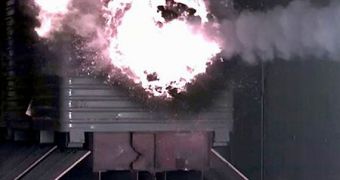When it comes to weapons, the U.S. Navy never seems to have enough of them or to make them as deadly as they wish them to be. Yesterday, engineers employed by the U.S. government tested an improved railgun design that is able to output a total power of 10 megajoules, breaking the record of the previous railgun, which had a power of 9 megajoules of muzzle energy.
Railguns are a type of weapons that convert electric power into kinetic energy, in order to propel a projectile. The principle used by the railgun is relatively similar to that of the linear electric motor in the design of maglev trains. What is the advantage of using such weapons? Well, because the kinetic energy to propel the projectile no longer depends on explosive propellants, but rather on the force of a magnetic field, railguns no longer suffer the limitations of speed imposed by the speed of sound in compressed gas.
Conductors through which electrical current is pumped generates a magnetic field on a direction perpendicular to that of the conductor. However, unlike classical electrical engines which require the presence of permanent magnetic fields generated by magnets, railguns use highly conductive metal projectiles to generate the second magnetic field. You may remember about the effects generated when a superconducting material is placed into a magnetic field. The magnetic field generated by the permanent magnet induces a current in the superconducting material that, due to its low resistivity, would create a secondary magnetic field that would interact with the first to levitate it into thin air.
The same basic principle applies to all conducting materials, not only to superconductors, but high intensity electric currents are required to obtain the desired effect. For example, the railgun weapon uses a power supply that is able to produce about one million amperes, propelling the projectile at speeds up to 20 kilometers per second. On the other hand, such speeds lead to excessive heat and high friction that rapidly erodes the rig.
Furthermore, railgun weapons require special materials and precautions. The materials used to construct it need to be highly conductive, in order to compensate for high current input, need to be strong enough to resist the violent acceleration of the projectile. The power supply must produce high currents, which can be obtained through the use of a combination of capacitors and compulsators (compensated pulsed alternator). Massive amounts of heat are generated during projectile acceleration, through the flow of high intensity currents and friction. Even by the use of a small mass projectile, the high-speed acceleration would give it enough impulse to produce a significant impact force, which would also produce a powerful recoil that wouldn't be absorbed by the weapon.
The U.S. Navy hopes that the railgun design will be used to replace all 5-inch guns of their ships, by the year 2020. Actually, the rig tested yesterday is able to propel a projectile with 35 megajoules of energy through the air, but the U.S. Navy plays safely and tests the railgun by slowly increasing the energy. If they want to replace the guns with the electric powered guns, the U.S. Navy would better find a way to produce such amounts of power on their ship, otherwise their as good as dead in the water.

 14 DAY TRIAL //
14 DAY TRIAL //